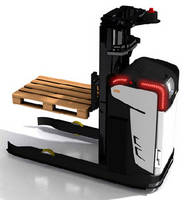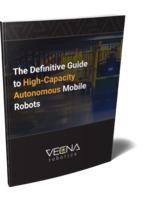Automated Guided Vehicle Systems
National Audit Lends More Credence to Replace Forklifts with Unmanned Vehicles
Share:

A recent announcement of South Australia's part in a national campaign to assess and improve forklift safety in the wholesale grocery and fruit/vegetable industries is, according to a top Australian industrial company, the first example of how Australia across the board is admitting traditional forklifts are not the way of the future.
Industrial Conveying (Aust) Pty Ltd, which has begun rollout of its Automated Warehouse Truck (AWTs), has been focusing on removing traditional forklift trucks from the workplace along with the inherent dangers they cause.
It has aided the development by dovetailing this new, safer technology with its ever-evolving dock loading systems that fully automate and speed-up delivery and despatch processes.
At the same time, a national campaign and audit is being conducted under the direction of the Heads of Workplace Safety Authorities (HWSA), which is the joint national body of Australia's OHSW authorities that includes SafeWork SA, into the dangers and costs of forklift injuries.
Industrial Conveying argues most jobs traditionally handled by forklifts can be adequately performed by completely automated AWT units, removing human traffic from the potential danger zones, thus allowing management to deploy existing staff to safer duties around the warehouse while the remote control AWTs deliver and retrieve palletised product to and from automated docks.
Managing Director of Industrial Conveying, Mr Don Erskine, says it is no surprise a national authority is making an audit on forklift related injuries during tasks such as loading and unloading vehicles, and it is not before time.
"Workplace audits by SafeWork SA were scheduled to begin in August 2010, so the proof is there that OH&S bodies are extremely serious about the pervasiveness of forklift injury and the blowout in Workers Compensation statistics.
"The HWSA reports injuries from manual tasks and moving objects in both the grocery and fruit/vegetable wholesale industries impose a financial burden on the Australian economy, and that is why we are adamant about the future being largely about AWTs."
South Australian statistics alone for the period 2005-08 show there were 2,800 forklift truck related claims, which resulted in total workers compensation costs in excess of $23 million.
The state-wide campaign will look at the safety of forklift truck operations, with SafeWork SA inspectors visiting work sites to assess the initial level of compliance and provide guidance, assistance and necessary enforcement to improve forklift operation safety
According to SafeWork SA, the campaign aims to assist employers to safeguard workers from injury, highlight the importance of systematically identifying hazards in workplaces and implement sustainable control measures to eliminate or minimise incidents.
"Results ARE expected by March 2011, but our company doesn't believe in waiting for more injuries and costs, so our AWT solution is already on the Australian market to replace the main cause of these- statistics wherever possible," said Mr Erskine.
"AWTs operate completely without driver assistance and navigate using a laser guided or a spot system (or a dual system using both).
"The laser guided system utilises a sensor on top of each truck that scans appropriately positioned reflectors to determine its position while it navigates and carries out inventory assignments."
Because human intervention is taken out of the equation, an AWT-based system does not stop for lunch breaks, can work multiple shifts without tiring, it does not take sick leave, and it improves overall OH&S as personnel involvement around AWTs is far lower than with lift trucks.
A 'high lift' option with a Tri-lateral head allows 180 degree rotation for fast access to all parts of a storage facility.
Industrial Conveying's dock loading systems are tailored cost efficiently for the end user to bulk load (and unload) palletised product to and from transport vehicles.
With this new technology, the vehicle/container is raised to a correct height to enable loading (and unloading) with powered skates that lift and carry the load on or off the vehicle. Timeframes for handling have been reduced drastically, effectively handing the user a competitive advantage in its own industry sector.
Working in sync with AWTs, automated dock systems cater for 20ft, 40ft and 48ft containers and trailers.
During the handling process, vehicle/container docking alignment is controlled and verified electronically. Equipment controls are easy to use and minimal training is required.
For more information, please contact Mr Don Erskine, Industrial Conveying (Aust) Pty Ltd.
145-147 Howard Street, Epsom, Victoria 3551, Australia.
Ph: (03) 5440 5100, web: www.icaust.com.au
Prepared by Val Pavlovic. Omentum Media Australia: ph: 0413869 589 admin@omentum.com.au



